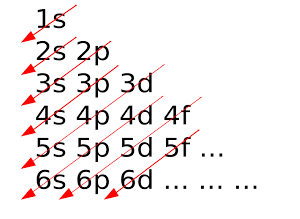
The electronic configuration of an element is $1{s^2}2{s^2}2{p^6}3{s^2}3{p^6}3{d^5}4{s^1}$. This represents:
A) excited state
B) ground state
C) cationic state
D) anionic state
Answer
490.2k+ views
Hint: The electronic configuration describes the filling of the electrons in different orbitals. The electrons are filled in the orbitals according to the Aufbau principle.
Complete step-by-step answer:
We know that, according to the Aufbau principle, the electrons are placed according to the order $1s\,2s\,2p\,3s\,3p\,4s\,3d\,4p\,5s\,4d\,5p\,6s\,4f\,5d\,6p\,7s$…….

There are also some exceptions to this Aufbau principle such as for ruthenium, silver, platinum and rhodium.
1. The given electronic configuration has 24 electrons. We know that chromium has the atomic number 24 in the periodic table. Chromium is placed in the 6th group. It is a transition element and is placed in the D-block of the periodic table. The filling of these 24 electrons in different orbitals according to Aufbau principle, we get the electronic configuration $1{s^2}2{s^2}2{p^6}3{s^2}3{p^6}3{d^5}4{s^1}$. This is the ground state electronic configuration of the element Chromium.
2. The same configuration can be exhibited by $(Mn^+)$ when it loses one electron and acquires a cationic state. So, this is also correct.
Hence, option (B) & (C) is correct.
Additional Information:
Dmitri Ivanovich Mendeleev on February 17, 1869 has first formulated the modern periodic table. The periodic table contains all the elements known to us. All the elements in the periodic table are grouped according to definite periods and groups. The elements placed in a particular group have similar properties such as chemical properties, reactivity etc. The elements in a group or in a period follow definite trends in size, atomic number etc.
Note: The students may get confused about writing down the electronic configuration of an element in the ground state and in the excited state. In the electronic configuration of an element in its excited state, the electrons in the outermost shell are placed in a higher energy orbital than that of the outermost electron in the ground state of that element.
Complete step-by-step answer:
We know that, according to the Aufbau principle, the electrons are placed according to the order $1s\,2s\,2p\,3s\,3p\,4s\,3d\,4p\,5s\,4d\,5p\,6s\,4f\,5d\,6p\,7s$…….

There are also some exceptions to this Aufbau principle such as for ruthenium, silver, platinum and rhodium.
1. The given electronic configuration has 24 electrons. We know that chromium has the atomic number 24 in the periodic table. Chromium is placed in the 6th group. It is a transition element and is placed in the D-block of the periodic table. The filling of these 24 electrons in different orbitals according to Aufbau principle, we get the electronic configuration $1{s^2}2{s^2}2{p^6}3{s^2}3{p^6}3{d^5}4{s^1}$. This is the ground state electronic configuration of the element Chromium.
2. The same configuration can be exhibited by $(Mn^+)$ when it loses one electron and acquires a cationic state. So, this is also correct.
Hence, option (B) & (C) is correct.
Additional Information:
Dmitri Ivanovich Mendeleev on February 17, 1869 has first formulated the modern periodic table. The periodic table contains all the elements known to us. All the elements in the periodic table are grouped according to definite periods and groups. The elements placed in a particular group have similar properties such as chemical properties, reactivity etc. The elements in a group or in a period follow definite trends in size, atomic number etc.
Note: The students may get confused about writing down the electronic configuration of an element in the ground state and in the excited state. In the electronic configuration of an element in its excited state, the electrons in the outermost shell are placed in a higher energy orbital than that of the outermost electron in the ground state of that element.
Recently Updated Pages
Master Class 11 Economics: Engaging Questions & Answers for Success

Master Class 11 Business Studies: Engaging Questions & Answers for Success

Master Class 11 Accountancy: Engaging Questions & Answers for Success

The correct geometry and hybridization for XeF4 are class 11 chemistry CBSE

Water softening by Clarks process uses ACalcium bicarbonate class 11 chemistry CBSE

With reference to graphite and diamond which of the class 11 chemistry CBSE

Trending doubts
What are the elders in Goa nostalgic about class 11 social science CBSE

Define least count of vernier callipers How do you class 11 physics CBSE

Write the differences between monocot plants and dicot class 11 biology CBSE

Which of the following is not a feature of the election class 11 social science CBSE

The mass of oxalic acid crystals H2C2O42H2O required class 11 chemistry CBSE

How many squares are there in a chess board A 1296 class 11 maths CBSE




